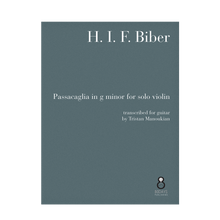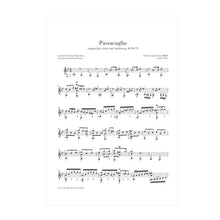The fifteen Rosary Sonatas are H. I. F. Biber’s masterpiece.
This extraordinary cycle, illustrating the fifteen Holy Mysteries, reveals unprecedented choices in violin writing, notably exploring a different scordatura for each sonata.
The Passagaglia in g minor (sometimes called The Guardian Angel in reference to the illustration in the manuscript) brings this incomparable cycle to a triumphant close, returning to the standard tuning of the violin. It has an emotional intensity comparable to that of J. S. Bach’s Chaconne BWV 1004.
Apart from the only known manuscript of these sonatas (no copies exist!), only a transcription for lute of the Passagaglia has come down to us, probably made by lutenist Johann Joachim Sautschek.
This transcription for modern guitar therefore seems entirely justified and relatively idiomatic. Furthermore, the g minor tuning is particularly suited to the guitar. I chose to detune the A and E strings to give the sound more openness and facilitate certain passages by freeing up the left hand. There are three main elements to consider when playing this piece: ornamentation, agogic accents, and nuances. It is likely that a great deal of freedom will need to be found in the last two in order to give a sensitive reading of this important work. it would be helpful to listen to interpretations on the baroque violin, Rachel Podger and Amandine Beyer in particular.
This arrangement was commissioned by Natalia Lipnistkaya, to whom it is naturally dedicated. The vast majority of the fingerings are the result of her magnificent interpretation, which can be heard in the video below.



